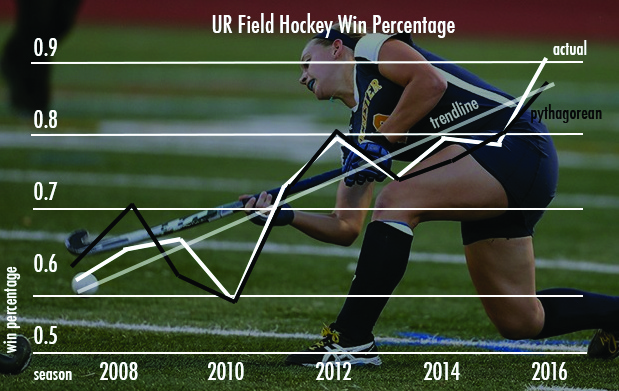UR Field Hockey (URFH) continued their flawless start on Thursday with a 3–0 victory against Brockport (1–4). The Yellowjackets (7–0) throttled their opponent to the tune of a 25–1 shot advantage, as well as an 18–0 edge on shots-on-goal.
Sophomore Nancy Bansbach, senior Callie Fisher, and freshman Amanda Guido had goals, assisted by senior Sayaka Abe, junior Samantha Dow, and Fisher, respectively.
The team is performing at a high level despite losing a number of key seniors from the previous season. This group included Michelle Relin ‘16, who scored a team-record 22 goals, polishing off a career that saw her post four of the top five Yellowjacket seasons ever in that category.
This year’s squad is continuing that legacy. As of Tuesday, UR was ranked 13 in the country in the coaches’ poll. The team was also ranked 15 overall by Kenneth Massey’s online statistical rankings, and 9 in defense. The team ranked 16 in goals allowed per game, largely thanks to junior goalkeeper Kiran Sundaram, who is ranked eighth individually in the country for that category.
The offense has kept pace with this performance, ranking 23 nationally in assists per game. Abe has lead the way, ranking 20 individually. The team’s two-way dominance also makes itself apparent by the team’s differential of a full two goals per game, a 10.1 margin in shots per game, and a 28 percent relative advantage in shooting percentage. This is despite the team playing a .571 strength of schedule so far, in contrast with the .431 mark they have to deal with in remaining games.
All of these stats paint a vivid picture of the Yellowjacket’s excellence, but one number is particularly appropriate to describe their success.
This number is pythagorean expectation, which is a formula created by baseball sabermetrics pioneer Bill James. Originally, the formula was (runs scored2)/(runs scored2+runs allowed2). If runs are changed to goals for translation to field hockey, the relation almost fits. The caveat, however, is that this formula does not translate directly to other sports. The exponent depends on the game and league: For example, 13.91 is used in the NBA, and 2.37 is used in the NFL. No such standard has been used for field hockey.
Using data from UR Field Hockey going to back 2003 in order to test out the exponent that best fit, the final adjusted formula came to (goals scored1.1)/(goals scored1.1+goals allowed1.1). (Note that it would have been more accurate to collect data from every team to reduce noise and possible bias from the team’s style of play.)
This year’s team, by that standard, should have been expected to win 79.4 percent of their games so far, as opposed to their perfect start. However, a team exceeding this expectation is probably benefitting from a mixture of statistical luck and an unusually strong ability to win close games.
UR Field Hockey has improved year-by-year with a strong trend. If projections from Massey Ratings prove accurate, that trend will increase this year. It’s worth mentioning that these projections are blind to the as-yet-unscheduled playoff games, which would be against stronger opponents. This would, however, do little to dampen the trend.
The ‘Jackets improved their record to 7–0 on Saturday, defeating Oneonta 3–1 with goals by Fisher and freshmen Maya Haigis and Guido. Assists came from Fisher and Abe.
The numbers are ultimately clear: the ‘Jackets are on a trajectory to the upper echelon, and they’re showing no signs of slowing. URFH will attempt to solidify these projections and extend their streak next Saturday at Union.

